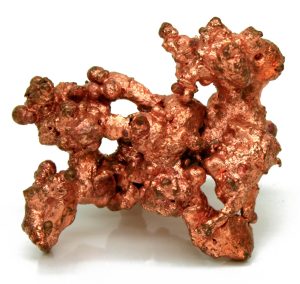2 Knowledge of Physical Sciences
Physical and chemical properties of matter

Do you remember the story of the three little pigs? The third little pig who survived used his knowledge of the properties of matter when he selected bricks to build his house. Properties of matter are the characteristics of a type of matter. Each type of matter, or substance, has unique characteristics that can be used to identify it.
The physical properties of matter can be observed and measured without changing the substance. Many physical properties (e.g., color, odor, texture, hardness) can be observed using your senses. In contrast, chemical properties of matter can only be observed when matter changes into a different substance. The new substance has different properties than the original substance. Table 1 lists examples of physical and chemical properties.
Table 1. Physical and chemical properties of matter
| Physical properties of matter | Chemical properties of matter |
|
|
Due to its unique properties, people have used copper to make tools, weapons, coins, and jewelry for thousands of years. Today, copper is mostly used in electrical equipment (e.g., motors, wiring). Below is a photo of pure copper. Table 2 describes some of the physical and chemical properties of copper.

Table 2. Physical and chemical properties of copper (Britannica, 2023; Kuntzleman et al, 2020)
| Physical properties of copper | Chemical properties |
|
|
Physical and chemical changes
Physical changes only modify some of the physical properties of a substance such as size or shape. They do not change the chemical makeup of substances or create new substances. Many physical changes including changes in state (e.g., melting, freezing) and dissolving some substances (e.g., sugar in iced tea) can be reversed.
What are some of the observations that you can make during a fireworks show? Your observations of the odor, heat, and light are clues pointing to the occurrence of chemical changes.

Below is a list of common signs of chemical changes:
- Change in odor
- Change in color
- Change in temperature
- Production of a gas (i.e., bubbles)
- Production of a solid (i.e., precipitate)
- Production of light
Chemical changes create new substances from existing ones. In the case of fireworks, when the black powder and coloring agents (metal salts) burn, ash and smoke are produced along with a colorful display. Additionally, the ash and smoke cannot be changed back into the black powder and coloring agents, meaning that this is an example of a non-reversible chemical change. Unlike physical changes, most chemical changes are non-reversible. Other examples of non-reversible chemical changes include cooking, rotting, and rusting.
Watch the video below to see a series of chemical change demonstrations that you could use in your future classroom.
“Chemical Changes: Fast and Slow”by funsciencedemos
phase changes
On Earth, substances are typically found in the state (phase) of solid, liquid, and/or gas. Two factors determine the phase of a substance:
- how fast the particles (atoms and molecules) of the substance move
- how strong the attraction is between the particles
The particles of gases move the fastest, overcoming the attraction between individual atoms and molecules. Due to this, the particles move freely and spread out in all directions, taking up the shape and volume of a container. The particles in liquids have moderate motion and can flow around each other. Since the particles of liquids still stick together slightly, they either fill the bottom of a container or form puddles on a surface. Much to the surprise of younger students, the volume of liquids remains constant regardless of the size/shape of their container. Finally, the particles of solids only vibrate slightly and the atoms and molecules are stuck together. This is why solids are able to keep both their shape and volume.
Explore the three phases of matter in the PhET simulation below.
When a solid substance is heated, its particles begin to move faster. The substance will first change to a liquid (melting) and then to a gas (vaporization) as the motion overcomes the attraction between particles. The opposite occurs when gaseous substances are cooled down. Particles in a gas begin to move slower and eventually, they cannot overcome the attraction between them. This results in the gas changing to a liquid (condensation) and to a solid (freezing). Go back to the PhET simulation above and explore how heating and cooling affect the phases of substances and particle motion.
Homogeneous and heterogeneous mixtures

How is a bowl of granola and a cup of tea different? How are they the same? While granola and tea look and taste very different and represent different phases of matter (e.g., solid, liquid), they are both types of mixtures. Since you can still see the individual substances (e.g., oats, nuts, dried fruit), granola is considered a heterogeneous mixture. Tea, on the other hand, is considered a homogeneous mixture because it looks like a single substance. You cannot see the individual substances (e.g., sugar, water). Another name for a homogeneous mixture is a solution. In a solution, the solute like sugar is dissolved in a solvent such as water. Solutions can come in all phases but they are usually the same phase as the solvent. Table 3 contains examples of different heterogeneous and homogeneous mixtures.
Table 3. Heterogeneous and homogeneous mixtures in your kitchen
| Heterogeneous mixtures | Homogeneous mixtures |
|
|
Since mixtures are only physically (not chemically) combined, they can be separated using various techniques. Some of the common methods include evaporation and filtration. Watch the following video to learn how engineers separate mixtures (heterogeneous mixtures) and solutions (homogeneous mixtures).
“Mixtures and Solutions” by TeachEngineering
atoms, elements, molecules, and compounds
Individual particles of matter are called atoms or molecules. These particles are incredibly small. How small? Watch the video below to find out how small atoms are.
“Just How Small Is an Atom?” by Jonathan Bergmann is licensed under CC BY NC ND 4.0.
Different kinds of atoms are known as elements. Currently, we know of 118 elements, of which 92 are naturally occurring and the remainder are lab-created. Each element has a different atomic number, which is the number of protons in the nuclei of its atoms. Each element also has its own set of physical and chemical properties. Elements with similar properties are grouped together in the periodic table of elements.
When two or more atoms combine chemically, they form a molecule. Most molecules are formed from atoms of different elements (e.g., one oxygen atom and two hydrogen atoms form a water molecule, H20). However, some molecules are composed of atoms of a single element (e.g., two oxygen atoms form an oxygen molecule, O2, two hydrogen atoms form a hydrogen molecule, H2).
Different kinds of molecules containing more than one element are called compounds. The physical and chemical properties of compounds are different from the elements that make them up. For example, table salt (sodium chloride) can be formed from sodium metal and chlorine gas. Sodium metal, as shown in the video below, is very reactive to water. Table salt, on the other hand, just dissolves in water.
“Reaction of Sodium and Water” by the North Carolina School of Science and Mathematics is licensed under CC BY 3.0.
potential and kinetic energy
Moving objects (and objects that could potentially move) have a specific form of energy called mechanical energy. There are two types of mechanical energy, kinetic energy and potential energy. Moving objects have kinetic energy due to their motion. Resting objects have potential energy because of their position or shape.
Use the PhET simulation to explore how the mechanical energy of a skateboarder changes between kinetic and potential energy as they skate. Make sure to click on the bar graph to see the total amounts of energy.
According to the bar graph, total amount of mechanical energy of the skateboarder does not change. This is an example of the law of conservation of energy. Energy can only change form (e.g., kinetic energy to potential energy) or be transferred from one object or system to another (e.g., from wheels of skateboard to ramp). It cannot be created or destroyed.
energy forms and transformations
Besides mechanical energy, there are many other forms of energy including heat (thermal) energy, light energy, sound energy, electrical energy, chemical energy, and nuclear energy. In energy transformations, energy changes from one form to another in objects or systems. The energy conversions of the skateboarder in the PhET simulation above are examples of energy transformations. At home, many common household devices convert electrical energy into different forms of energy as shown in Table 4.
Table 4. Energy transformations in electrical devices
| Device | After energy transformation |
|
|
The energy transformations of living things are essential for life on Earth. Plants and algae transform light energy from the sun into chemical energy during photosynthesis. Conversely, animals transform the chemical energy in food to mechanical and thermal energy.
heat transfer
What do you imagine happening when you put your hand around a hot cup of coffee?
Heat is the movement of thermal energy from a higher temperature object to a lower temperature object. Thermal energy moves from the cup of coffee into your hand and the temperature of your hand, or its average kinetic energy, gradually rises. The heat transfer between your hand and the coffee cup will continue until they are at the same temperature.
Heat transfer happens in one of three ways: conduction (as in the coffee cup example), convection, or radiation.
- Conduction: The transfer of thermal energy between two objects that are in direct contact with each other.
- Convection: The transfer of thermal energy through the movement of fluids such as gases and liquids.
- Radiation: The transfer of thermal energy through electromagnetic waves (e.g., visible light, infrared).
Watch the video below to learn more about the three methods of heat transfer.
Heat Transfer: Conduction, Convection and Radiation by WISC-Online is licensed under CC BY 3.0.
electrical circuits
Electrical circuits are crucial for lighting our homes, cooking our food, and providing many modern day amenities. Electrical circuits are composed of a source of electrical energy and a path for the electricity to travel. In simple circuits, the source is often a battery. Wires connected to a source such as a battery allow the electricity to flow in a continuous loop. The wires are made of a metal that conducts electricity well like copper. The wires are covered in an insulator like plastic to prevent electric shocks, electric leakage, and corrosion. The wires are also connected to a load which converts the electrical energy into another form. For instance, a light bulb can convert electrical energy into light energy and a fan can convert electrical energy into mechanical energy.
Explore creating a complete (closed) electrical circuit and lighting up the light bulb using the PhET simulation below. If there is any break in the path, the circuit will be incomplete (open), the electricity will not flow, and the light bulb will not light up.
forces and motion
Contact forces are forces that act between two physically touching objects. Examples include friction, tension (e.g., on a rope), air resistance, and pushes and pulls (i.e., applied forces). On the other hand, non-contact forces are those that act at a distance and do not require physical contact. These forces include gravitational force, magnetic force, and electrostatic force.
Consider a book sitting on a wooden table. The book is not moving at all. Are any forces acting on the book?
Indeed, two forces are acting on the book. The force of gravity is pulling the book towards the Earth. The table is pushing back just as strongly. Since the two forces are balanced, the book does not move. Balanced forces do not cause a change in an object’s motion.
However, maybe termites have been eating the table and the strength of the table has been compromised. When the force of gravity on the book is greater than what the table can exert, the table collapses and the book falls down to the ground. In this case, the unbalanced forces caused a change in the object’s motion.
Use the PhET simulation below to make and test predictions about force and motion.
FTCE K-6 physical SCience outcomes
Below are the outcomes related to the Physical Sciences competency for the FTCE K-6 exam:
- Identify and differentiate among the physical properties of matter (e.g., mass, volume, texture, hardness, freezing point).
- Identify and differentiate between physical and chemical changes (e.g., tearing, burning, rusting).
- Compare the properties of matter during phase changes through the addition and/or removal of energy (e.g., boiling, condensation, evaporation).
- Differentiate between the properties of homogeneous mixtures (i.e., solutions) and heterogeneous mixtures.
- Identify examples of and relationships among atoms, elements, molecules, and compounds.
- Identify and compare potential and kinetic energy.
- Differentiate among forms of energy, transformations of energy, and their real-world applications (e.g., chemical, electrical, mechanical, heat, light, sound).
- Distinguish among temperature, heat, and forms of heat transfer (e.g., conduction, convection, radiation).
- Analyze the functionality of an electrical circuit based on its conductors, insulators, and components.
- Identify and apply the characteristics of contact forces (e.g., push, pull, friction), at-a-distance forces (e.g., magnetic, gravitational, electrostatic), and their effects on matter (e.g., motion, speed).
References
Britannica, The Editors of Encyclopaedia (2023, May 22). Copper. Encyclopedia Britannica. https://www.britannica.com/science/copper
The green substance produced from the reaction between copper and oxygen, which gradually builds up on the surface of copper objects like the Statue of Liberty

